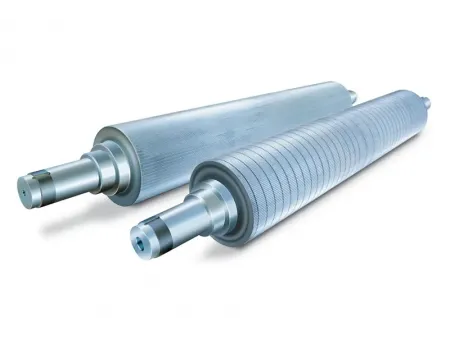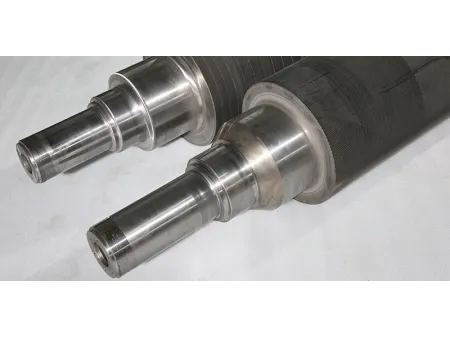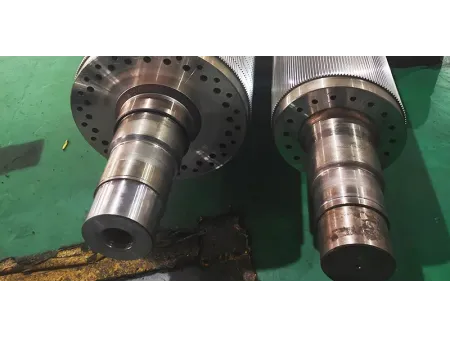Tungsten Carbide Coated Corrugating Rolls
Corrugated Machine Parts
Corrugating rolls with tungsten-carbide finish used in single facer machine for corrugated paper production
- The service life of tungsten carbide coated rolls reaches over 50 million meters, verified through long-term industry use
- Surface roughness achieved through precision polishing is Ra 0.2–0.4, ideal for high-speed corrugator lines
| Flute Type | A | C | CB | B | BE | E | F | G | N | O |
| Flute Profile | UV | UV | UV | UV | UV | UV | UV | UV | UV | UV |
| Number of Flutes (Flutes/300mm) | 30±2 | 39±3 | 44±2 | 50±2 | 66±3 | 90±10 | 124±10 | 185±12 | 200±15 | 267 or designed |
| Flute Height | 4.6-4.9 | 3.6-3.9 | 3.0-3.5 | 2.6-2.9 | 1.9-2.1 | 1.1-1.5 | 0.7-0.8 | 0.5-0.65 | 0.4-0.5 | 0.25-0.35 |
| Take-Up Ratio (T.U.R) | 1.51-1.59 | 1.44-1.51 | 1.42-1.49 | 1.36-1.42 | 1.4-1.41 | 1.29-1.39 | 1.22-1.26 | 1.2-1.25 | 1.15 or designed | 1.14 or designed |
* Note: Flute types are customized based on the customer's requirements and the grammage range of liner and medium paper.
Our tungsten carbide corrugating rolls are coated using the JP8000 supersonic flame spraying system, applying tungsten carbide powder at particle speeds above 800 m/s and flame temperatures below 1400°C. The coating process keeps the roll body temperature under 80°C, helping to minimize thermal stress during application.
The resulting surface achieves a hardness of HV0.3 > 1200 and a bonding strength of 6b > 70 N/mm², ensuring strong adhesion that remains stable over long-term use. The coating is dense, corrosion-resistant, and evenly applied, with a thickness deviation of less than ±0.01 mm. Roll runout is also controlled within 0.01 mm to ensure consistent precision. Compared to hard chrome plating, these corrugating rolls offer 5 to 8 times higher wear resistance, reducing maintenance needs and extending service life. A post-coating polishing process brings surface roughness down to Ra 0.2–0.4, fully meeting the demands of high-speed corrugator lines. The durability and uniformity of the coating help maintain board thickness, reduce paper waste, and keep production stable. In real-world use, our tungsten carbide coated rolls have achieved service lives exceeding 50 million meters.
Tungsten carbide coated corrugating rolls are compatible with a wide range of single facers from both international and domestic brands. They can be adapted to corrugating equipment from BHS, Fosber, Mitsubishi, BW Papersystems, Marquip, Peters, Isowa, Agnati, JS, TCY, West River, Hsieh Hsu, K&H, and XHL, among others.
- The coating bonds firmly to the base material, ensuring long-term durability without peeling or flaking.
- With high surface hardness, wear resistance is significantly improved, extending roll lifespan in a consistent and measurable way.
- Coating thickness is uniform and precisely controlled, helping maintain high dimensional accuracy throughout use.
- After treatment, rolls are polished to a surface roughness of Ra 0.2–0.4, fully meeting the needs of high-speed production lines.
- When combined with UV and UVV flute profiles, the design helps increase board strength, reduce glue usage, and minimize core paper waste.
- The flute shape remains stable during use and does not wear down over time, maintaining consistent paper take-up rates.
- Corrugated board produced with these rolls maintains consistent thickness and flatness, supporting reliable printing and box quality.
- The coating can be removed using specialized techniques, allowing the roll body to be reused.
- Fewer replacements mean reduced downtime and lower labor and material costs.
- Tungsten carbide coating provides extremely high hardness, second only to diamond, with wear resistance far superior to chrome-plated rolls.
- Service life is extended by 3 to 5 times, reducing roll replacement frequency by 65% to 80%.
- Flute height loss is minimal, only 0.06 to 0.08 mm per cycle, helping maintain flute shape throughout use.
- Optimized flute design reduces paper consumption by 1% to 6%, lowering production costs.
- Stable flute tips result in consistent glue usage, cutting starch glue consumption by 20% to 40%.
- Lower wear reduces machine downtime and limits the damage to other parts like glue rolls and pressure rolls.
- Uniform coating quality prevents glue fluctuations, decreasing board defects and reducing scrap rates by 30% to 50%.
- Consistent flute geometry ensures stable board thickness, improved bonding, and reliable box quality.
- Custom flute profile design is available based on board performance and economic analysis.
- Roll parameters can be adjusted during refurbishing or new production to help lower overall operating costs and increase competitiveness.
| Item | Tungsten Carbide Coated Corrugating Roll | Conventional Chrome Plated Corrugating Roll |
| Service Life | Extended by 3–5 times | Regular replacement cycle (prone to wear and frequent changes) |
| Paper Consumption Rate | Reduced by 1%–6% | Higher (due to flute tip wear causing paper waste) |
| Glue Consumption | Reduced by 20%–40%, with more consistent usage | Large fluctuations, unstable consumption |
| Maintenance Costs | Less downtime, fewer roll changes and related damage | Frequent maintenance, higher overall costs |
| Scrap Rate | Reduced by 30%–50% | Higher (flute wear leads to poor bonding and quality issues) |
Made from 50CrMoA forged alloy steel sourced from Zhongyuan Special Steel, a top-tier Chinese supplier. The material offers high strength, wear resistance, and thermal stability, ideal for high-speed corrugating applications.
- 50CrMoA forged alloy steel for strength and durability
- Corrugating roll body thickness ≥ 75 mm
Praxair JP8000 supersonic flame spraying machine combined with tungsten carbide powder ensures a uniform coating with a thickness variation of less than ±0.01 mm and surface hardness reaching HV1200–1500.
- Praxair JP8000 thermal spray system
- Sand blasting
- Tungsten carbide coating
Composite hardening process combining nitriding, quenching, tempering, and cryogenic treatment (–190 °C), achieving a surface hardness of HRC ≥ 60.
- Combined heat treatment
- Nitriding
- Medium frequency quenching
Vacuum-sealed with anti-rust protection and packed in shock-resistant wooden crates, suitable for long-distance sea transport.
The quality control system includes 12 strict steps, covering every stage from raw materials to the finished product.
The process involves:
Raw material testing → weld air-tightness → dynamic balancing → hardness, flute profile and dimensions → pressure testing → coating thickness → final inspection.




